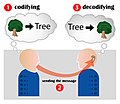Structured literacy
Structured literacy (SL), according to the International Dyslexia Association (which coined the term), is the systematic teaching of reading that focuses on the following elements: [7]
- Phonology: the sound structure of spoken words and Phonemic awareness (the ability to recognize, segment, blend, and manipulate sounds)
- Sound-symbol association (also Phonics): using the Alphabetic principle to connect sounds (phonemes) to letters (graphemes)
- Syllables: part of a word with one vowel sound, with or without a consonant (e.g., The word reading has two syllables, "read" and "ing".)
- Morphology: the smallest unit of meaning in a language (e.g., The word unbreakable has three morphemes, "un", "break", and "able".)
- Syntax: grammar, sentence structure, etc.
- Semantics: meaning.
SL is taught using the following principles:[1]
- Systematic: begin with the basic and easiest concepts and elements, and progress to the more difficult and complex
- Cumulative: each step builds on a previous step
- Explicit: direct teaching and continuous teacher-student interaction
- Multisensory: using different senses (e.g., visual, auditory, kinesthetic, and tactile) to enhance attention and memory
- Diagnostic: using informal and formal assessments to individualize instruction
The International Dyslexia Association provides a detailed outline of its Key Performance Standards of its Knowledge and Practice Standards for Teachers of Reading.[8]
It is beneficial for all early literacy learners, especially those with reading disabilities such as dyslexia.[14]
Structured literacy vs. Balanced literacy
[edit]SL has many of the elements of systematic phonics and few of the elements of balanced literacy. The following is an explanation of how Structured literacy is different from Balanced literacy:[1]
| Feature | Structured literacy | Balanced literacy |
|---|---|---|
| Basis | Science of reading[15] | Whole language[15] |
| Areas covered | Phonology, phonemic awareness, sound-symbol association, syllables, morphology, syntax, and semantics[16] | Learn from exposure, reading, instruction, and support in multiple environments[16] |
| Teaching method | Direct, explicit, systematic, cumulative, and multisensory[16]
Mostly teacher-led (e.g., The teacher leads the students through decoding activities.)[17] Lessons involve phonics and word reading, from easier to more difficult[17] Corrective feedback: students are asked to "sound-out" the word[17] |
Implicit, constructivist, and less structured[18]
Often student-directed (e.g., independent learning, students choose reading material, etc.)[17] Lessons relate to comprehension of books or literature themes.[17] Corrective feedback: students are asked "does that make sense", and are told to check the cues (e.g., pictures, first letter, etc.)[17] |
| Phonics | Taught via the alphabetic principle, systematically, including the most frequent phonemes (sounds) and graphemes (letters), beginning with the easiest and progressing to the more complex[16] | Taught as needed via mini-lessons, or not at all[16] |
| Text for reading instruction | Decodable text until grade 2[17] | Leveled text, but not corresponding to phonics taught[17] |
| Reading | decoding and sounding out words[16] | read the whole word using cues (context, word analogies, and pictures) to guess the word[16] |
| Effectiveness | a mean unweighted effect size of .47, and a fixed weighted mean effect size of .44.
Structured literacy approaches "tend to yield larger positive effects on student learning compared to balanced literacy approaches". (meta-analysis 2024)[19] |
a mean unweighted effect size of .21, and a weighted mean effect size of .33.[19] |
See also
[edit]References
[edit]- ^ a b c d "What Is Structured Literacy, International Dyslexia Association, Pikesville, MD, USA". 2016.
- ^ "Structured Literacy, An Introductory Guide, International Dyslexia Association, Pikesville, MD, USA" (PDF). 2019.
- ^ "Structured Literacy Instruction: The Basics, Reading rockets".
- ^ Spear-Swerling, Louise (2019). "EDUCATOR TRAINING INITIATIVES BRIEF Structured Literacy, an Introductory Guide".
- ^ "What is Structured Literacy, Kentucky Department of Education". September 10, 2025.
- ^ Jennifer S. Ray. "Structured Literacy Supports All Learners: Students At-Risk of Literacy Acquisition – Dyslexia and English Learners" (PDF). ISSN 2374-0590.
- ^ Sources:[1][2][3][4][5][6]
- ^ "Knowledge and Practice Standards for Teachers of Reading". 2018.
- ^ Louise Spear-Swerling (2018-01-23). "Structured Literacy and Typical Literacy Practices". Council for Exceptional Children, Arlington, VA, USA. 51 (3). doi:10.1177/0040059917750160. S2CID 149516059.
- ^ Center, Yola; Freeman, Louela (1996). "The Use of a Structured Literacy Program to Facilitate the Inclusion of Marginal and Special Education Students into Regular Classes" (PDF). Sydney, NSW, Australia: School of Education Macquarie University.
- ^ Heidi Turchan (March 28, 2023). "Partner spotlight: Putting the science of reading into practice".
- ^ "Colorado dyslexia handbook, Structured literacy".
- ^ "Instructional Approaches in Language, Department of education, Ontario Canada". 2023.
- ^ Sources:[1][9][10][11][12][13]
- ^ a b "Four things you need to know about the new reading wars, Jill Barshay, The Hechinger Report, #2". 30 March 2020.
- ^ a b c d e f g Gibson, Kenny; Hall, Julie Anne; Angrum, Cartessia (April 14, 2021). "Structured Literacy vs Balanced Literacy, Mississippi Department of Education" (PDF).
- ^ a b c d e f g h Louisa Cook Moats (2020). Speech to print, language essentials for teachers. p. 255. ISBN 9781681253305.
- ^ Lorimor-Easley, Nina A.; Reed, Deborah K. (April 9, 2019). "An Explanation of Structured Literacy, and a Comparison to Balanced Literacy, The University of Iowa".
- ^ a b Hansford, Nathaniel; Dueker, Scott; Garforth, Kathryn; Grande, Jill D. (2024). "Structured Literacy Compared to Balanced Literacy: A meta-analysis". doi:10.17605/OSF.IO/K7Y4C – via ResearchGate.

